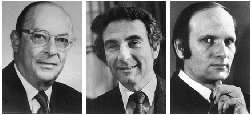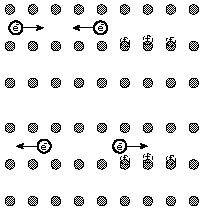|
|
|
In 1933 it was determined by Walter Meissner and Robert Ochsenfeld that superconductive materials can repel magnetic fields. They determined that when a material was penetrated with a magnetic field, in its' superconductive state, it would create a current inside the superconductor. Because there is almost zero resistance in the material at its' Tc temperature, the current creates an opposing magnetic field that exactly balances the originating field. When the material's temperature becomes higher than its' Tc value the magnetic field simply pass through it. This was an extraordinary discovery and thus the term "Meissner Effect" was coined to describe this unexpected occurrence. Ceramic superconductors have made it considerably easier to view the Meissner Effect due to their higher Tc values. (1) |
|
|
In 1957 three physicists, John Bardeen, Leon Cooper, and John Schrieffer, came up with a theory to explain the phenomena which occurred when a magnetic field penetrated a superconductor. The theory became known as the BCS (Bardeen Cooper Schrieffer) Theory. The theory states that when penetrated by a magnetic field electrons in the superconductor pair up, also known as Cooper Pairing. As the electrons pass by atom nuclei in the superconductor they attract the nuclei. This causes the paired electron moving in the opposite direction to be attracted toward the shifted nuclei. A domino effect is created and more electrons begin to displace within the superconductor thus setting up a current. See the image below for a visual description. (1,2,3) |
 John Bardeen, Leon Cooper, and John Schrieffer (http://www.superconductors.org/bcs_pics.jpg) |
 (http://230nsc1.phy-astr.gsu.edu/hbase/ solids/imgsol/bcs9.gif) |
|
|
References |
|